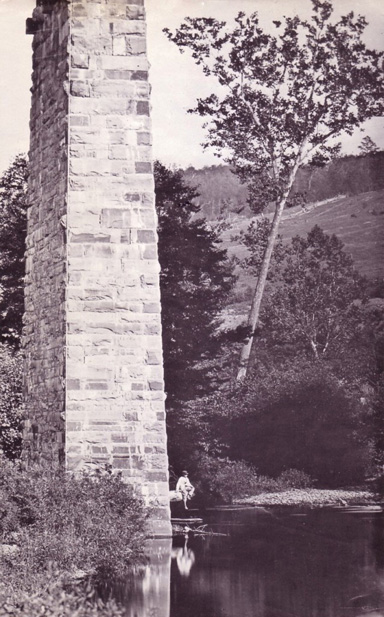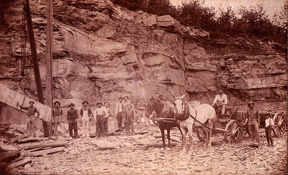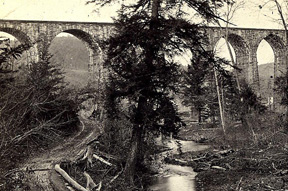Montrose – The worst storm of the year swooped down on us yesterday, Wednesday, and almost completely paralyzed every activity of our citizens. At the hour the average Montroser bestirs himself in the morning a heavy snow was falling, there already being an accumulation of several inches. It snowed constantly all day long, the total being estimated at 16 inches. The city carriers got out and wallowed in the snow, making what deliveries they could. None of the rural [mail] carriers succeeded in leaving and the schools had a one-session day. The Lehigh Valley reached Montrose on about schedule and the Montrose branch of the DL&W made the morning trip with little difficulty, but an extra engine was necessary to bring the train into town. At 12:30, when negotiating the deep drifts on a switch at the Montrose Dairy Co.’s plant, the huge engine hurled off the rails. An extra locomotive and the flanger both got stuck in the big drifts on “the dump” between the creamery and the station, thus adding to the troubles. By 6 o’clock the engine at the creamery had been gotten up on the rails again and at 6:56 the train pulled out for Alford, to attempt the second trip of the day. At the time this was written, 7 P.M., the Lehigh Valley had reached Springville, about 3 hours late, and expected more serious trouble at this end of the line. The drifts about town are from 8 to 12 ft. high. The streets are full of snow, and the sidewalks are simply grooves, and full of snow at that. Thursday, from phone messages from Clifford, Silver Lake, Rush, Dimock and other places, it seems that the County is badly snow-bound. It stopped snowing about 9 P.M. The cold is intense this morning, the mercury standing at zero. However, the sun came out early and the day promises to be a beautiful one.
Springville – In a conversation with W. A. Taylor the other day, he alluded to the common belief that Springville was named because of the presence of a number of large springs in the neighboring hillsides. He enlightened me with the information that the town got its name from one T. D. Spring, who owned a large farm where the town now stands. Mr. Taylor is not well three score and ten, but says he can recall every resident and the location of their homes, as it was fifty years ago. ALSO R. L. Avery and Prof. Hardy have bought a store at Nichols, N. Y. and will take it over about the middle of May. It will be a serious loss to this town to have these two leave, as they have been greatly interested in the advancement of anything that helped to build up the place. Mr. Avery will leave soon for his new home, and Harry Lee will occupy the Avery place.
Susquehanna – During the month of February there were 72,972 cars moved in the Susquehanna yards of the Erie railroad. This was an average per-day of 2,513 cars.
West Auburn – James Babcock, of Wilkes-Barre, manager of J. J. Smith & Sons poultry farm, is expected here with his family soon. J. J. Smith is also expected to come up this season and make extensive repairs on the building of Elm Farm.
Elk Lake – Supervisor Broadhead is busy keeping the roads open for the pubic. Many places it is necessary to go through the fields.
Forest Lake – Mrs. Jerry Donovan and daughter, Frances, and son, Richard, spent a few days at the home of her brother, Joseph Kelly.
South Harford – Elijah Harding, one of our oldest and highly respected neighbors, passed away March 7th. ALSO We have our share of snow banks, but our mail man wallows and shovels through every day.
Choconut Valley – The stage on the Friendsville and Binghamton route failed to make its trip Monday, Feb. 28th. For the first time this winter, as it was impossible to get through the snow drifts, Searle Clarke, who delivers the R. F. D. mail, also failed to make his trip. The bear failed to see his shadow Feb. 2d, but we have not seen fine weather yet.
Clifford – A new boiler has recently been placed in the Clifford creamery, it having taken several days to complete the job. Meantime the milk usually coming here was sent to Lenoxville. A large quantity to cream was accumulated awaiting the starting of the churn.
Rush/Meshoppen – Dr. A. L. Hickok, for many years a practicing physician at Rush, but who more recently has been located at Meshoppen, announces that he will discontinue his office at the latter place to accept a position as company physician with the Maplewood Chemical Co., at Shinhopple, N.Y., a town about 80 miles north of Binghamton.
Dimock – Dimock added another scalp to her trophies last Saturday night, at Hop Bottom, when they won in a closely contested game from Hoop Bottom High School by a score of 33 to 29. During the last half the Dimock boys were never headed but the Hop Bottom boys were running a close second. But in the end it proved that a passing game is superior to dribbling.
News Brief: Twenty-eight years ago Wednesday, the memorable blizzard of 1888 started. This was one of the worst blizzards the country ever experienced. If it is true that we experience a repetition of the same weather conditions every seven years, the heavy snow of Wednesday would seem to bear out the theory of the weather moving in cycles. About 18 inches of snow fell during the day. ALSO We hear much complaint over the fact that the state roads are not cleared of snow causing great inconvenience and much expense to those who are obliged to use them. The township supervisors, in many instances, claim that they have no right to go on and do the work, and that this matter should be taken care of by the State Highway Department. The road from Montrose to Rush is said to have been in very bad shape for a long time. One man remarked to us the other day that he was drawing a ton of lime at a trip, when he should draw two tons.
200 Years Ago: MARRIED, in this town [Montrose] on the 17th instant [present month], by Joshua W. Raynsford Esq., Mr. Jonas Ingham, of Wyalusing (Bradford Co.) to Miss Sally Robinson, of this place. On the same day, by the Rev. Ebinezer Kingsbury, of Harford, Mr. Hezekiah Bullard, to Miss Matilda Deans.
Milford & Owego Turnpike Road. The managers of the Milford and Owego Turnpike Road Company are requested to meet at the house of Edward Fuller, in Montrose, on the second Monday in May next, at one o’clock in the afternoon, on business of importance. B. T. Case, Secretary, March 16th, 1816.

In 2005, the United States Supreme Court ruled in Roper v. Simmons that the death penalty for juvenile homicide offenses was cruel and unusual punishment - and was therefore unconstitutional. At that point, juvenile offenders, i.e., those under 18 years of age when the homicide was committed, could not be put to death as punishment for their crimes. In a 5-4 decision, the Court noted studies that the juvenile brain was not yet mature at the age of 18 as further evidenced by various laws that limited the rights of juveniles, i.e., military service, voting, restrictions on purchasing certain products, serving on juries, marriage licenses. The Court also noted that juveniles were more easily influenced by peer pressure to do things that they would not have otherwise done in the absence of such outside negative influence.
The Court also found that there was an international consensus that prohibited the execution of juveniles – and that the United States was one of the only nations still permitting such executions. Further, many state legislatures had abolished juvenile executions demonstrating a growing consensus that juvenile offenders did not have the requisite maturity or culpability so as to warrant the death penalty. Given the domestic and international consensus against the execution of juvenile offenders, coupled with the studies demonstrating the immaturity of the juvenile brain, the Court determined that execution of juvenile offenders was cruel and unusual punishment.
In 2010, in Graham v. Florida, the United States Supreme Court by a 5-4 vote determined that a life sentence for a juvenile offender for a non-homicide offense constituted cruel and unusual punishment. Graham built upon Roper in noting the immaturity of juvenile offenders made the imposition of life sentences for non-homicide offenses cruel and unusual punishment.
In 2012, following Roper and Graham, the United States Supreme Court ruled in Miller v. Alabama (in another 5-4 vote) that it was cruel and unusual punishment to impose a mandatory life sentence without the possibility of parole to a juvenile offender convicted of homicide. Again, the Court emphasized the lack of maturity and decreased impulse control that differentiated a juvenile offender from an adult offender.
Miller seemingly opened the door to juvenile offenders serving life sentences without the possibility of parole to seek judicial relief. Miller appeared to give those juvenile offenders the chance of getting out of jail. After Miller, the state and federal courts began to differ as to whether Miller applied prospectively or retroactively. If it only applied prospectively, then those juvenile offenders already sentenced would have no relief, but the courts could not impose life sentences without parole in future cases. The Pennsylvania Supreme Court determined that Miller was not entitled to retroactive application – and only applied to pending juvenile homicide cases.
Thereafter, the question again made its way to the United States Supreme Court, and on January 25, 2016, the Court (by a 6-3 vote) determined that Miller was intended to be applied retroactively, i.e., it applied to the juvenile offenders already sentenced and serving to mandatory life sentences at the time Miller was decided. Pennsylvania has 479 juvenile offenders serving life sentences – which stunningly accounts for nearly one-fifth of the total number of juvenile offenders nationwide impacted by Miller and Montgomery. Pennsylvania courts are now struggling on how to implement handle the wave of requests from these juvenile offenders seeking a new sentence.
Is there a new sentencing proceeding? Does the Court simply make the juvenile offender eligible for parole and allow the parole board to make the decision? Given that first degree murder only has one punishment for first degree murder, does the sentencing court have the power to fashion a sentence for which there is no statutory authority to support it?
Miller did not prohibit life sentences for juvenile offenders convicted of first degree murder but the record had to demonstrate that the sentencing court had considered the individualized factors of the juvenile offender prior to making that decision. If the Court is going to undertake such an individualized consideration of the juvenile offender, what records will the Court consider? What records are still available given that decades have transpired with some of these cases? Can the Court also consider the juvenile offender’s correctional history in the sentencing process?
Miller and Montgomery have opened up 479 mandatory life sentences without the possibility of parole for juvenile offenders convicted of first degree homicide – but the courts will continue to struggle with the implementation as to how to handle the new sentencing proceedings.
Chapter 3 – Stone quarries and building the bridge.
Superintendent James Kirkwood and bridge designer Julius Adams, like generals in the army must have had some great and sharp individuals under him to pull off the coordination and find the expertise needed to complete the task at hand, a stone viaduct over the Starrucca Valley. Needed immediately was lumber for the scaffolding of the structure. A young local school teacher and entrepreneur named Simon Barnes provided the half million feet of lumber that were used for the scaffolding and falsework needed. As a side note, this is the same Simon Barnes whose name is used for our local hospital here in present day Susquehanna.

Early 1850’s, one of the earliest known pictures. Notice the young man sitting on a log in the lower right corner. Pickett fences can be seen on the almost bare mountain behind the viaduct.
Pennsylvania has an abundance of “blue stone”,considered the best stone in the world by many and several stone quarries were used; one on the mountain behind “pig-pen alley” road, another and still used to this day behind the Lanesboro Cemetery, but the main suppliers were up at Brandt and Stevens Point. A double rail system on both sides of the Starrucca Creek was used to haul the stone down to the worksite from Brandt, being pushed along by animals, no trains. One of the haulers was a 14 year old boy with a team of oxen, named Wesson Lamb. His future grandson, also named Wesson would also own and operate Lamb’s Dairy here in Susquehanna. Wesson Lamb is also my late wife’s grandfather, so a connection is made in our family to a laborer working at that time on the viaduct. There are two other local individuals also known to have worked on it, to be mentioned later. 14 year old Wesson was paid $1.00 a day, mostly 12 hour days. It is noted that he took great care of his oxen team.

These men provided some of the stone used during the Viaduct construction. This shows what a windlass, or gin-pole looked like. These were instrumental for the workers at the bridge also, along with derricks pulley’s, strong backs and strong animals. That was just about all they had to get the job done.
Initial work was started in 1847 but was a failure and abandoned. James Kirkwood came to the aid of Erie’s desperation and work started in May 1848. With the labor force encamped and growing, the first thing needed was the foundations for the piers, dug deep and wide with only the tools available at the time. Four men were digging at each pier. Some had water seepage problems and had to devise a plunger pump device to extract the water. The men went down until they hit bedrock, 6 to 9 feet in some cases and then filled in with stone and cement to surface level, resembling a marble top.

This Picture demonstrates the original, very muddy road to Brandt and Stevens Point. Wooden rails from both sides of the creek at Brandt were utilized to haul stone to the viaduct construction site. Parts of one side turned, eventually into the D&H rail bed and the other side the present day highway.
Without all the technicalities of how the bridge was built, it proceeded fast in the summer of 1848. A little machine shop was built alongside it to sharpen tools, make tools like chisels and hammers, a very busy place. Another local named John Fritchley was a very busy young man in the blacksmith/machine shop. His last name is unfamiliar to me, perhaps somebody can come forward as a relative of his, names change along the way. He is known to have stayed in the Lanesboro area afterwards.
I was recently on a mission to find evidence of some of the known local workers on the bridge. One was Thomas Beavan, great-great-grandfather of LeGrande Beavan, past owner of the Penn Can Speedway and local business man with a car dealership in Oakland. A family member of his gave me a clue that he might be buried in that little cemetery below the Windsor Golf Course; he also indicated he lived near that area back in 1848. I found his grave site at that cemetery, alongside that of his wife. He also had a GAR marker on his grave, “Grand Republic of the Army”; he was a Union Civil War Veteran. It is known that he walked 5 miles to and from work on the viaduct every day, often 12 hour days, for a dollar a day. Imagine that! He must have found a way over the river, to avoid going all the way around.
Next on my research list was Wesson Lamb, the oxen worker. Because he is related I knew that his grandson was buried in the North Jackson cemetery. I easily found him but did not find his grandfather Wesson’s grave; it is kind of a big cemetery. I did go online and find him there, on the North Jackson Cemetery website. The website also lists relatives and siblings of the deceased and I found an interesting connection with my children and step children regarding who they are related to locally. It kind of surprised me. One of the reasons I love the old history is, like a puzzle, it makes little sense until you fit some pieces.
NEXT CHAPTER 4 – Work continues and the town explodes.


















